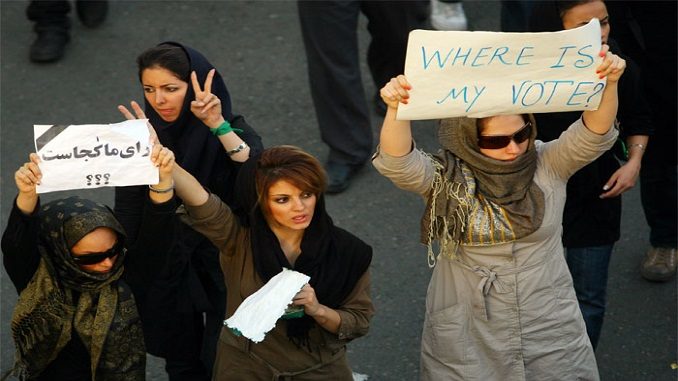
According to the recently released World Economic Forum’s Global Gender Gap report, Iran is among the five worst countries in the world when it comes to improving women’s rights, parity, and equality. The Islamic Republic of Iran is ranked 140th of 144 countries, ahead of only Chad, Syria, Pakistan, and Yemen, Track Persia reports.
The report measures gender equality using various parameters, including economic participation, health and survival, healthy life expectancy, political empowerment and opportunity, and education. While the majority of countries in the Middle East have shown progress, the Islamic Republic of Iran is heading in a negative direction.
According to the WEF’s report, Iran has gone backward “on the educational attainment and health and survival gender gaps”. This is happening while other countries in the region have improved. For example, according to the report, Saudi Arabia “re-closes its gender gap in enrolment in primary education” and sees progress “in gender parity for professional and technical workers.”
The findings are intriguing as they highlight the fact that Iran’s deteriorating stance on gender parity is occurring under the watch of the so-called “moderate” president, Hassan Rouhani, and his Moderation and Development Party. Rouhani made promises that he would improve women’s economic situation, create jobs and enhance their rights.
Nevertheless, after his election, not only did Rouhani not fulfill his promises, but he gave a freer rein to the Islamic Revolutionary Guard Corps, the Ministry of Intelligence, the militia group Basij, and the judiciary to crack down on women. His first proposed names for cabinet ministers were also all male.
This is a strategy that the Islamic Republic has used since its foundation in 1979. In order to mobilize women and obtain their support, the officials make promises to improve women’s conditions. Nevertheless, after they assume power, women’s rights not only take a back seat on their agenda but actually further deteriorate.
It is worth noting that the worst area for women in Iran is the economic participation gap and the difference between women and men in the labor force. Iran ranks 143rd of the 144 countries, followed only by Syria at the bottom of the list. Iran scored 0.225 while the average is 0.667 — this means that the gender gap in the economic landscape is roughly three times greater than the average.
Women from minority ethnic and religious groups such as Sunnis, Christians, Arabs, and Kurds suffer the most. Naghmeh, a 26-year-old woman from Tehran, told Human Rights Watch:
“I am a mechanical engineer and I was interviewed for a position in Iran’s oil and gas fields… My contact in the company told me that they really liked me, but that they did not want to hire a woman to go to the field.”
In addition, these findings show that the nuclear deal has not benefited the overwhelming majority of the Iranian people, as advocates of the deal had predicted. President Rouhani promised the nuclear agreement would improve the economic standards of the population because of the relief of sanctions. But the WEF’s report clearly shows that half of the country’s population, Iranian women, have not benefited at all.
This is due to the fact that the regime has not taken any concrete initiatives or legislative moves to ensure that women would benefit from the extra billions of dollars that the regime is receiving. The IRGC and the office of the Supreme Leader, Ali Khamenei, have been the major beneficiaries. Rouhani has further intensified the unequal economic reality.
Official figures indicate that 42 percent of Iranian women between the ages of 15 and 29 are unemployed. And Iran has the highest brain drain in the world, with many skilled and talented women leaving Iran for better economic opportunities.
Finally, the Iranian regime is not only among the world leaders in the execution of minors, according to Amnesty International, but Tehran is also among the worst when it comes to executions of women. Many women in Iran’s prisons, specifically in the notorious Evin Prison, which is known as a torture factory, say they would prefer to die than endure the atrocities and heinous acts committed by the Iranian regime.
In conclusion, although the Iranian regime’s revenues have substantially increased, the situation of women under the presidency of the “moderate” Rouhani has significantly deteriorated. Rouhani has failed to fulfill his promises. This also ought to be a warning sign for those who call for more business with the Iranian regime and advocate for more appeasement policies toward the ruling mullahs.
